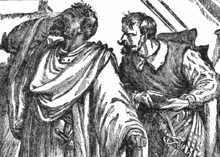
His religion and the way he looks creates many road blocks for him when he marries Desdemona. His religion and the way he looks creates many road blocks for him when he marries Desdemona.

Othello is the only one of the operas three main characters that is multidimensional.
Religion in othello. Race Religion Othello the Moor of Venice. As Ive mentioned before Moor was Elizabethan shorthand for Muslim though through the Middle Ages the Moors were widely supposed to be mostly black or very dark-skinned moor Oxford. Othello is the only one of the operas three main characters that is multidimensional.
This is an important facet of Verdis depiction of religious themes in the work. The other two Iago and. Othello has converted to Christianity and the preoccupation with good and evil in the play suggests its religious context.
The central figures of many of Shakespeares plays including Othello are frequently individuals beset by temptation and the lure of evil. Shakespeares heroes have the preoccupation with self and the introspective tendencies encouraged by Protestantism. In Othello Shakespeare emphasizes the inability of religion to protect from harm in order to bring attention to the dangers of placing trust in a false security.
The failure of Gods protection forces the audience to contemplate if religion is a legitimate form of protection or rather fuel for a false reality. Othello is unable to rise up in rank socially due to his religion but is able to due to his military abilities. His religion and the way he looks creates many road blocks for him when he marries Desdemona.
The same prejudice that existed 400-500 years ago is. Reader view Roman Catholicism. Five duties of Islam.
Handkerchief is a sign of fidelity. In the play Othello tells us that the handkerchief given to his mother by a. Christianity and Islam clashes.
During the time in which The Tragedy of Othello the Moor of Venice is set issues of religion culture race and gender all contributed to whether or. The study aims at analyzing the Moors character as a Muslim and his paradoxical action throughout William Shakespeares Othello. The paper is divided into three sections.
The first one is a brief introduction. It is concentrated on the western perspective of. Othello explicitly includes race and religion as a fundamental part of the motivations behind theshow more content During the early 17th century when Othello takes place a Muslim character would have been strongly disliked and would be offered no chance for redemption from a Christian society.
Othellos love for Desdemona is like a religious devotion and often expressed in terms of heaven and hell. When he says Perdition catch my soul But I do love thee Act 3 Scene 3 he is equating the power of his love as being worth the threat of damnation though he does not mean that such a love would actually damn him - ironically. Thus in Shakespeares Othello the connotation of the religious motifs throughout are used to develop the idea that even the most loving couples have their flaws leaving them vulnerable to the destructive powers of jealousy brought on by the manipulative influences of others resulting in suspicion and ultimately betrayal.
The seemingly perfect love between Othello and Desdemona is. Religious The food that to him now is as luscious as locusts shall be to him shortly as bitter as coloquintida. 13345346 This is an allusion to Saint John the Baptist who ate locusts and prophesized the coming of Gods Final Judgement.
Act 2 scene 1. In fact since the arrest scene is associated with Othellos marriage to Desdemona it suggests that Othello is a Christ-like husband to his bride alluding to the well-known Biblical picture of Christ and His church. Yet Othello is unavoidably Shakespeares most nuanced attempt at a Muslim character.
A general in the Venetian army he is repeatedly praised by his peers as a very gallant man noble and. Contexts Historical context Female subordination DudaevaShutterstock. Although questions were being asked about the social hierarchy women remained in subordinate roles their lives controlled by patriarchy during the Renaissance.
Women expected to be ruled by men as Desdemonas submission to Othello demonstrates. The period when Shakespeare was writing was one torn by disagreements over the proper method of observing Christianity in England. Protestantism was at war with Catholicism and the Church of England often employed coercion and even violence to enforce its hegemony.
By doing this Othello himself is making a big mistake as killing someone was thought to be one of the biggest sins against ones religion and belief in the gift of life. As it was suspected Natural order was restored in the closing scenes of Othello with Othello killing. Shakespeare is a subtle author when it comes to religion and throughout Othello Iago never directly addresses his religious beliefs.
Yet one passage in particular that of Iagos attempt to persuade Roderigo to control his passions makes the case for Iagos true atheism. Othello is a Christian its true but he is descended from Muslims. Shakespeares subtitle The Moor of Venice would have suggested Islam as well as blackness.
And the conflict that threatens Venice in the play is with the Muslim Turks.